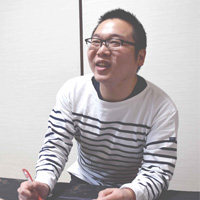Shimpei Matsuzaki
- Lacquerware
- 1981 -

Loosely translated, “urushi” means Japanese lacquer, but in fact urushi is distinct from other kinds of lacquer. Urushi itself is a natural sap that comes from a particular type of tree that grows in East Asia, which in Japanese we call the “urushi no ki,” or “the urushi tree.”
I use traditional urushi materials and techniques to make works of art.
To make an object using urushi, I start with a wooden body, which is a piece of wood that I carve to the basic shape, for example a box or a bowl.
Then, I paint this wood with many coats of urushi. These numerous layers of urushi will make the body of the piece strong. I apply a coat of urushi, I let it harden, then I polish the surface. I repeat this process many times until I have as many layers as needed.
Urushi requires a humid environment to cure and harden properly. For that reason, after I apply each layer of urushi, I put the piece on a shelf in my bathroom. The urushi absorbs a little of the moisture so it can harden properly without drying out.
A carefuly and properly made piece of urushi is durable enough that is can be used by several generations in a family.
I use and teach various techniques for decorating urushi, for example with pieces of shell and other materials.
Japan is lucky to have four distinct seasons, and I like to express these in my urushi art. On the surfaces of my urushi pieces, I create pictures of the natural landscape—flower, trees, leaves, oceans, rivers, mountains, wind….
My goal is to portray these using beautiful colors. One ideal material for this is “mother-of-pearl,” which is made from thin pieces of shellfish shell. The color tones from these shell fragments are a perfect match for urushi.
The process for using mother-of-pearl is very intricate and time-consuming. First I must shave the shell and polish it very thinly, usually using a machine tool. Then I cut the shell into pieces and set these into the urushi surface to make my pattern. I coat them with more urushi, let it harden, then polish the surface. I repeat this process—coating, hardening, and polishing—until the surface and the picture are perfect.
This traditional method is very time consuming, but I think it makes a very nice and beautiful end result!
| Membership | Full member, Japan Kogei Association Lecturer at Okinawa Prefectural University of Arts, Urushi Lacquering Course Director at the Japan Cultural Property Lacquer Association |
|---|
- 1981 Born in Tokyo
- 2005 Graduated from the Department of Crafts (Urushi-Art) in the Faculty of Fine Arts, Tokyo University of the Arts
- 2007 Completed his Master’s Degree in Urushi-Art at the Graduate School of Fine Arts, Tokyo University of the Arts
Joined Kiriya Tanaka Inc. as a kiri wood chest of drawers factory production staff member (Up until 2009) - 2009 Educational research assistant at the Urushi-Art Laboratory, Tokyo University of the Arts (Up until 2012)
- 2011 2nd Cross-straits Creative Tea Utensils Design Exhibition (Wuyi Shan, Fujian Province, China)
Engaged in the restoration works of Kirikane designs on a glass vessel, a Byodoin Phoenix Hall artefact - 2012 Part-time lecturer at the Urushi-Art Laboratory, Tokyo University of the Arts
Urushi Art – History and the Future (The University Art Museum, Tokyo University of the Arts) - 2013 2013 Hubei International Triennial of Lacquer Art (Hubei Province, China)
International Lacquer Art Exhibition (Daegu, South Korea)
Taiwan-Japan Lacquer Exchange Exhibition – The Past, Present and Future Exhibition (The University Art Museum Chinretsukan Gallery, Tokyo University of the Arts, )
From Crafts to Kogei – In Commemoration of the 60th Japan Traditional Art Crafts Exhibition (Crafts Gallery, the National Museum of Modern Art, Tokyo) - 2015 Solo exhibition “The color”(Nihonbashi Mitsukoshi Main Store Art Salon)
- 2016 Kogei (Modern Crafts) and the Tea Ceremony II from the Museum Collection (Crafts Gallery, The National Museum of Modern Art, Tokyo)
- 2017 [Decorative but Calm/by Japanese Artists with modern craftsmanship] (Daiwa Foundation Japan House Gallery, London)
- 2018 Present of Lacquer Art (Ginza Wako hall)
URUSHI Tradition and Innovation (Ishikawa Prefectural Museum of Art, SOGO Museum of Art, MOA Museum of Art) - 2019 Solo exhibition "night and sea" (Nihombashi Mitsukoshi Main Store Art Choice Gallery)
- 2020 Evaluator at the 60th East Japan Traditional Kōgei Exhibition
- 2022 The Way of Paintings 2022 FACE Award Winners (Sompo Museum of Art)
- Present
Lecturer, Okinawa Prefectural University of Arts URUSHI major
Full member, Japan Kogei Association
Director, Japan Association for Urushi Cultural Heritage
- 2004Received the Harada Award (Tokyo University of the Arts Harada Scholarship)
- 2009Received the Yamatane Museum of Art Award at the 49th East Japan Traditional Kōgei Exhibition
- 2010Received the Japan Kōgei Association Incentive Award at the 57th Japan Traditional Kōgei Exhibition
Received the Excellence Award at the International Chi Art Exhibition, Fujian Museum, Fuzhou, China - 2013Received the Incentive Award at the 53rd East Japan Traditional Kōgei Exhibition
- 2015Received the Nezu Museum Director's Award at the 55th East Japan Traditional Kōgei Exhibition
- 2019Received the Excellence Award and Audience Award at the Frontier Artists Contest Exhibition 2019 Sompo Japan Nipponkoa Art Award Exhibition (Seiji Togo Memorial Nipponkoa Museum of Art)
Received the Incentive Award at the 59th East Japan Traditional Kōgei Exhibition
Received the Excellence Award at the BVLGARI MECENATE - 2022Received the Okinawa Times Award at the 56th West Japan Traditional Kōgei Exhibition
- National Crafts Museum (Ishikawa)
- Wajima Museum of Urushi Art
- Tafu Gallery (Fujian, China)
- Ise Foundation












